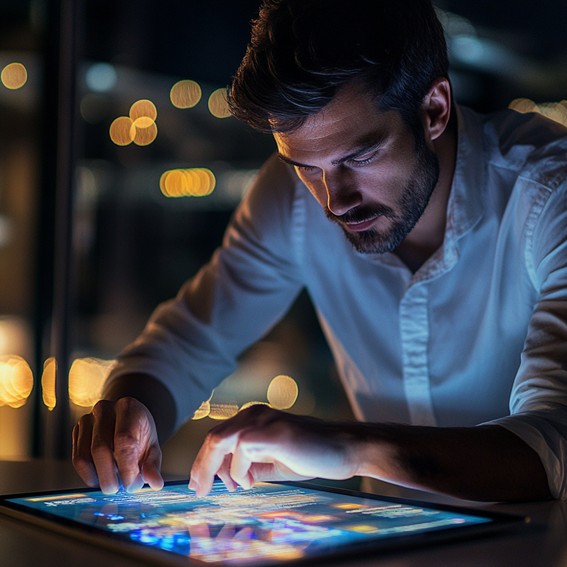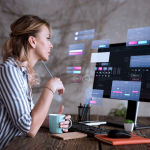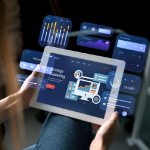
UX Design: How to Turn a FRUSTRATED User into a FAN
Have you ever stopped to think that every click, every tap on the screen, every interaction you have with anything digital is like an invisible choreography? That’s UX Design – or, if you prefer, the art of not making you rack your brain trying to use an app, website, or any other digital gizmo.
Let me tell you a story that might sound familiar: you go into an online store determined to buy that smartphone you’ve been eyeing for weeks. You pick it, toss it into the cart, and when it’s time to check out… surprise! You’re redirected to a registration page. “Alright,” you think, “I’ll fill this out quickly.” You complete everything, but when you return, the cart is empty. That’s right, empty! Now you have to go search for the product all over again. Feels like giving up, doesn’t it? Well, this is a classic example of a painful user experience (UX).
Let’s simplify things: UX Design isn’t just about making things look pretty. It's more about understanding the quirks of the user, how they think, and what they expect when using a product or service – whether digital or physical. The goal is to make everything flow so smoothly that it feels like magic. The objective? Avoid frustrations like the one with the online store.
At the heart of UX Design, there’s a magical word: usability. If the user can use the thing easily, quickly, and without stress, points for the designer. Jakob Nielsen, the “father of usability,” says usability is the measure of how easy it is for someone to navigate an interface. In short: if you make the user want to throw their phone at the wall, you’ve failed. Big time.

UX vs. UI: What’s the Difference?
Many people think UX and UI (User Interface Design) are the same thing. Spoiler: they’re not. UX is about the entire experience, the “feeling” of using the product. UI, on the other hand, is more visual – the neat buttons, cool colors, and so on.
Think of it this way: the UX Designer is like the architect who designs the house layout, making sure it’s functional, accessible, and everything else. The UI Designer is the interior decorator, the one who chooses the wall colors, furniture, and all the details that make the house cozy.
The Charm of Visual UX Design
Now, talking about beauty, Visual UX Design is the spice that makes things shine. Here, everything comes into play: colors, typography, images, icons, and the page layout. If done right, users will love browsing, and the chances of them returning increase exponentially.
They’re like the product’s moods. They make you feel, guide you along the way, and when used well, tell a story just by looking at the screen.
This is about choosing the right font so that the text is pleasant to read and matches the brand’s style.
This is the treasure map. If well-designed, the user finds everything they need without having to dig too deep.
A well-chosen image is worth a thousand words, and a well-placed graphic can work wonders for clarity.
UCD: Design That Thinks About You
There’s a philosophy in UX that’s the cherry on top: User-Centered Design (UCD). The name says it all, right? Here, the idea is that the entire design process should revolve around what the user truly wants and needs. It’s not about looking good just for the sake of it. It’s about solving real problems.
Why Invest in UX?
Simple: because it brings results. With good UX Design, you:
- Keep Users Satisfied: An intuitive and easy-to-use interface is halfway to winning over the customer.
- Increase Conversion: Want the user to buy, sign up, or take any action? UX removes obstacles from their path.
- Foster Customer Loyalty: Happy customers return and even recommend you to others. That’s some valuable word-of-mouth.
- Reduce Costs: Avoiding usability issues early on means spending less on support and rework later.
UX is the Key to Success
In the end, investing in UX ensures that your digital product or service not only works but also wins hearts and minds. And let’s be honest, who doesn’t love seeing numbers go up while customers shower you with praise?

Murillo Melo
CEO do Dialogi
Author
FAQ
It focuses on understanding and meeting user needs, creating intuitive and seamless interactions.
UX focuses on the overall experience, such as functionality and usability. UI handles the visual design, including colors, buttons, and layout.
It ensures satisfaction, streamlines actions like purchases or sign-ups, and builds user loyalty while reducing support costs.
Dialogi AI
Find out how our solutions with empat. AI can revolutionize customer service in your business.
Recent Post
- All Posts
- Customer Experience
- Design and Communication
- Ethics and Society
- Evolution and Impact of AI
Categories
Tags
Dialogi | AI | Human-Machine Interaction | Virtual Assistants | Automation | Future of Technology | Digital Communication



